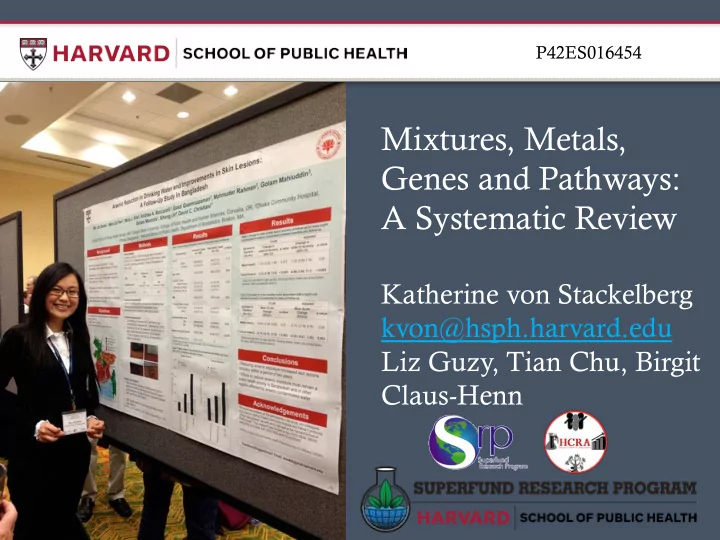

P42ES016454 Mixtures, Metals, Genes and Pathways: A Systematic Review Katherine von Stackelberg kvon@hsph.harvard.edu Liz Guzy, Tian Chu, Birgit Claus-Henn
Superfund Research Program at HSPH Prenatal and perinatal exposures to mixtures of metals (arsenic, lead, manganese; cadmium) and neurodevelopmental health outcomes in children
Emerging Issues in Risk Assessment Cumulative risk Non-chemical stressors Chemical mixtures Susceptibility Environmental equity / justice Gene-environment interaction Epigenetics Exposure Bioavailability Exposome Timing of exposure
Synthesizing Evidence from Exposure to Health Outcome ● Genetic Dose susceptibility/ Mode(s) of action interaction Exposure models BBDR models PBPK models Disease etiology Systems Disease models models Exposure Internal Target Early biological Altered Disease Dose tissue dose effects structure function EXPOSURE biomonitoring Intersection and modeling PBPK synthesis of effect data, exposures in the environment, and EFFECT disease etiology in vivo and in vitro DISEASE ETIOLOGY tox assays cellular events epidemiology subclinical disease molecular epidemiology
Adverse Outcome Pathway
Components of Systematic Review E PI T OX G ENE I NTERACTION E XPOSURE H EALTH O UTCOME 22 11 in Genes within a health Compare exposure Autism studies vitro ; outcome; genes across levels from epi studies ADHD 32 in vivo health outcomes within a to NHANES; other Neuronal function metal; genes relevant to biomonitoring studies in cognition and pathways learning Outcome Pb As Mn Cd ADHD DRD2 , GRM5 LPHN3 DRD2 , SLC6A3, TACR1 DRD2 , DRD4, TACR1 ADORA2A, APP , CRP, DRD2 , APP , DRD2 , FOS , SLC6A3, Anxiety Disorders MAOA CRHR1, FOS , SLC6A4 , TNF FOS , MIF, NPY, SERPINA1, TNF , UCN SLC6A4 , TNF Asperger Syndrome SLC6A4 SLC6A4 ADM , AR, BCL2 , BDNF , CAT , BCL2 , BDNF , CAT , CP, ADM , BCL2 , BDNF , CAT , DRD3, EGR2, GHR, GJA1, GABRA1, GAD1, GRIN2A , GSTM1, GSTP1 , HLA- , DRB1 , GPX1, GSTP1 , IFNG , IGF1 , HLA- , DRB1 , HRAS, IFNG , IGF1 , IL10 , IL1RN , IL2 , IL6 , ADM , AQP4, BDNF , CAT , IGF2, IL10 , IL1RN , IL4, IL6 , IGF1 , ITGB3, JMJD1C, LAMB1, LEP , MEF2C, FOXP2, GRIN2A , IFNG , IL2 , Autism MET , MIF, MTF1, NOS2 , MAOA, MECP2, MET , NOS2 , MTHFR, NOS2 , PDE4B, PER1 , IL6 , LEP , NOS2 , PARK2, PER1 , PLA2G4A, PLAUR , NTRK2, PON1 , PRKCB, PLAUR , PON1 , PRF1, PTGS2 , PTGS2 , SLC1A3 , TF POMC, PRL, PTGS2 , SCT, PTGS2 , ROBO1, SLC1A3 , SCN7A, SERPINE1 , SLC6A4 , SEMA5A, SERPINE1 , SND1, TF , TNFRSF1B, XDH XPC SLC40A1, SLC6A4 , TF Child development GRIN2B , HFE , ITGB3, LAMC3, FOXP1, MEF2C, SOX9 GRIN2B , HFE DRD4 disorders, pervasive MECP2 APP , DRD2 , DRD3, EPO , APOE , APP , DRD2 , MET , APOE , MT1 , MT2 , APP , DRD2 , EPO , PTGS2 , Cognition disorders IGF2, MET , MT1 , MT2 , PTGS2 , PTGS2 , SLC1A1 PTGS2 , SLC6A4 SLC4A10 SLC6A4 Intellectual disability BDNF , GAMT, GNAS, GRIN2B , BDNF, MEF2C BDNF, GRIN2B , SLC4A10 BDNF , FGFR2 MECP2 BMP2, FTH1, FTL, HAMP, Iron metabolism CP, HMOX1 HMOX1 , SLC11A2 , SOD1, TNF HMOX1 , TFRC HMOX1 , SLC11A2 , SLC40A1, disorders SOD1, TF, TFNC, TNF ACHE , APP , BCL2 , CASP3 , ACHE , BCL2 , CASP3 , HMOX1 , ACHE , APP , BCL2 , CASP3 , APP , CASP3 , HMOX1 , HTR1A , Learning Disorder HMOX1 , IL1B, MAPT , MECP2, HTR1A,IL1B , MAPT , MT1 , MT2 HMOX1 , IL1B , MT1 , MT2 , TH, IL1B , PARK2, TH, VEGFA TH, TRH , TH, VEGFA VEGFA ACHE, APP, BCL2, HTR6, IL1B, Memory disorders MAPT Notes: Red - gene in common across all four metals; blue - gene in common across three metals; green - gene in common across two metals
Evidence Along the AOP Continuum Genetics Epigenetics Molecular Initiating Event Cellular response Organ Response Organism response Decreased performance on Polymorphisms DNA Phosphorylation Neurotransmitter Disruptions in developmental in metal uptake methylation of MEK release neuronal tests and metabolism signaling Inhibition of Apoptosis IQ point Na + /K + -ATPase Disruptions in ROS formation decrements neuronal Increase in Ca 2+ Heme function Specific biosynthesis developmental disorders such as ADHD, autism
Question Review What criteria should be used to evaluate the applicability of different research synthesis methods to particular types of problems and data? Criteria will vary given decision context Resource availability Time constraints External review Qualitative vs. quantitative Within our review, used different criteria across domains Decision tree or flow chart
Question Review What particular characteristics of the problem and data make the research synthesis method(s) you address particularly well (or poorly) suited for that context? Context: risk, public health, exposure, regulatory toxicology Synthesizing evidence across domains Moving toward mechanistic understanding of complex interactions leading to health outcomes
Question Review What are the strengths and limitations of the outputs provided, and the implications for their use in policy analysis? Establish a baseline Integrative Qualitative Policy context (risk assessment)
Question Review What are the most important research needs, in terms of methodological development, given your findings? Quantitative methods for translating AOP into regulatory values (e.g., IRIS) Implications for risk assessment more broadly Standardized approach(es) within a domain? “universal” standards for judging acceptability/suitability of specific studies
Concluding Ideas Evidence that prenatal or perinatal exposures to mixtures of metals are associated with greater than additive neurodevelopmental health outcomes in children Several modes of action by which this could occur Support for proposed adverse outcome pathway Complexity across the continuum from exposure to health outcome requires synthesis and integration in an evidence-based analysis Greater reliance on high-throughput methods Tiered modeling approaches Method development within a domain Kernel machine regression Variety of methods discussed here Meta analysis Weight of evidence Systems based approaches Bayesian structural equation models
Recommend
More recommend